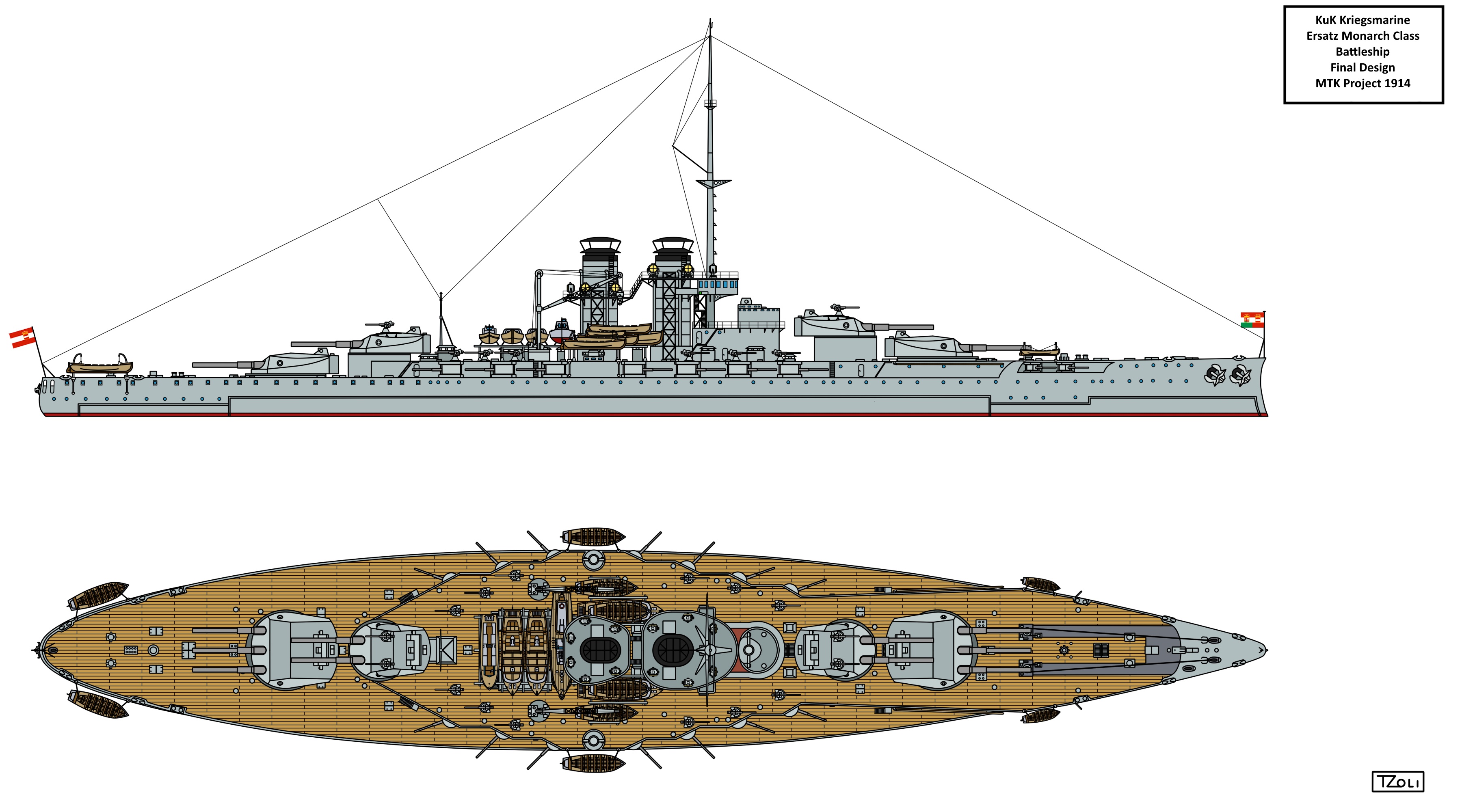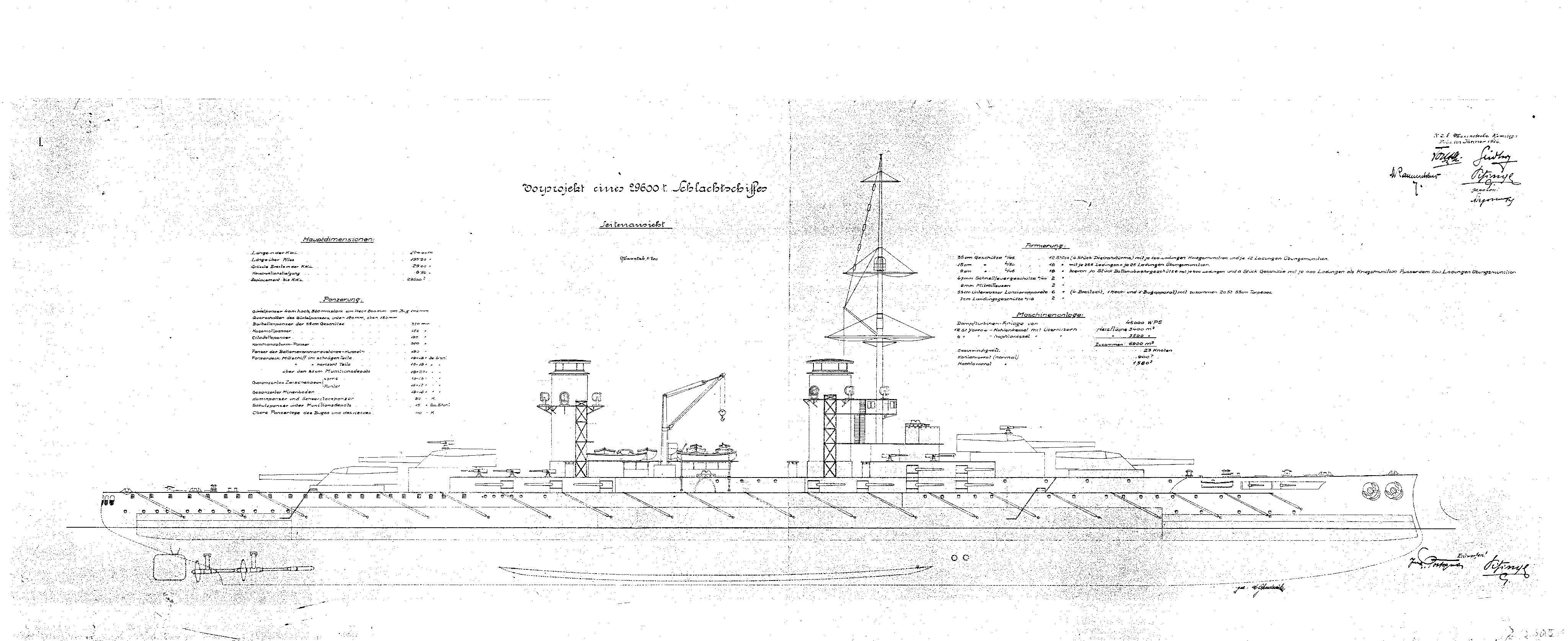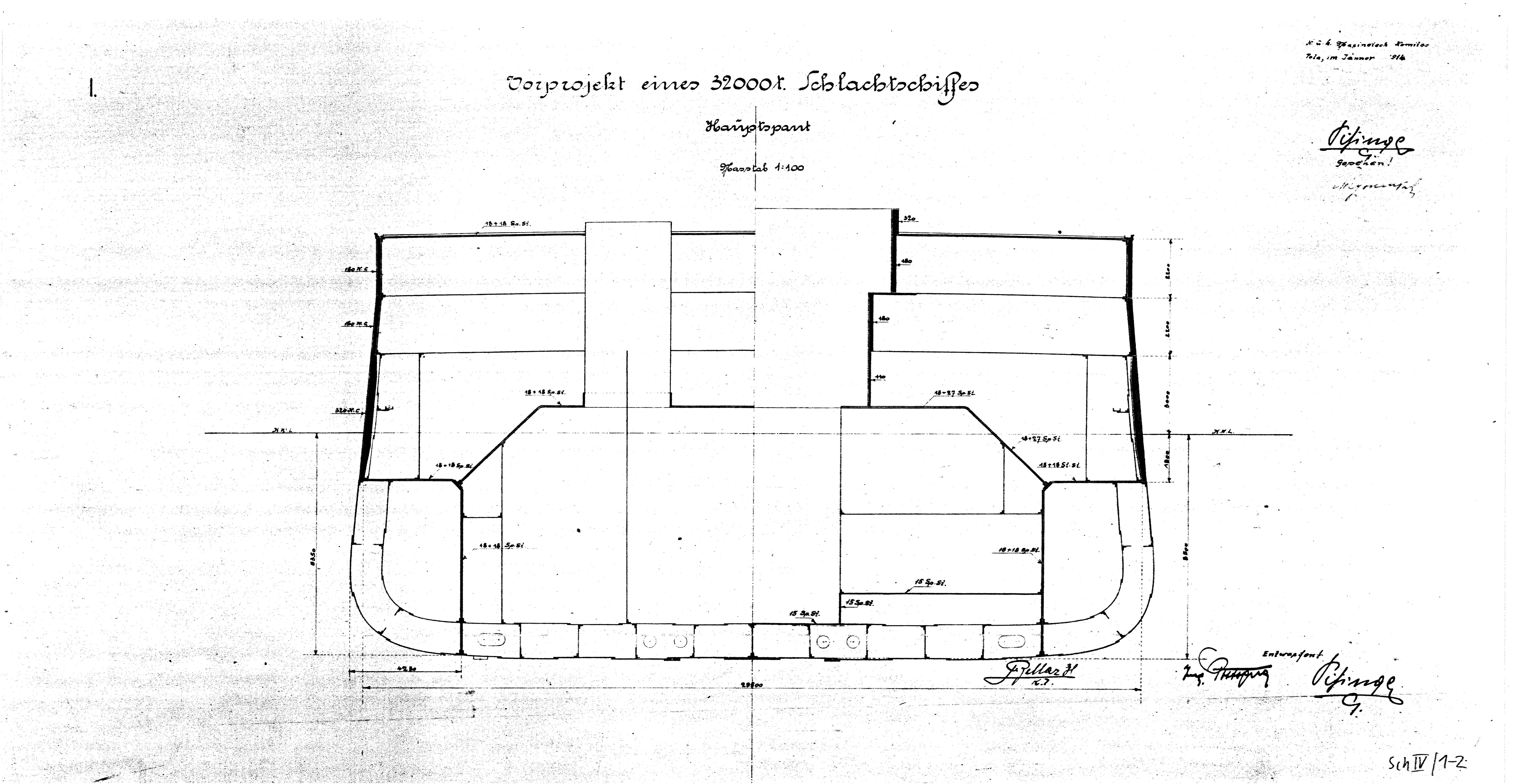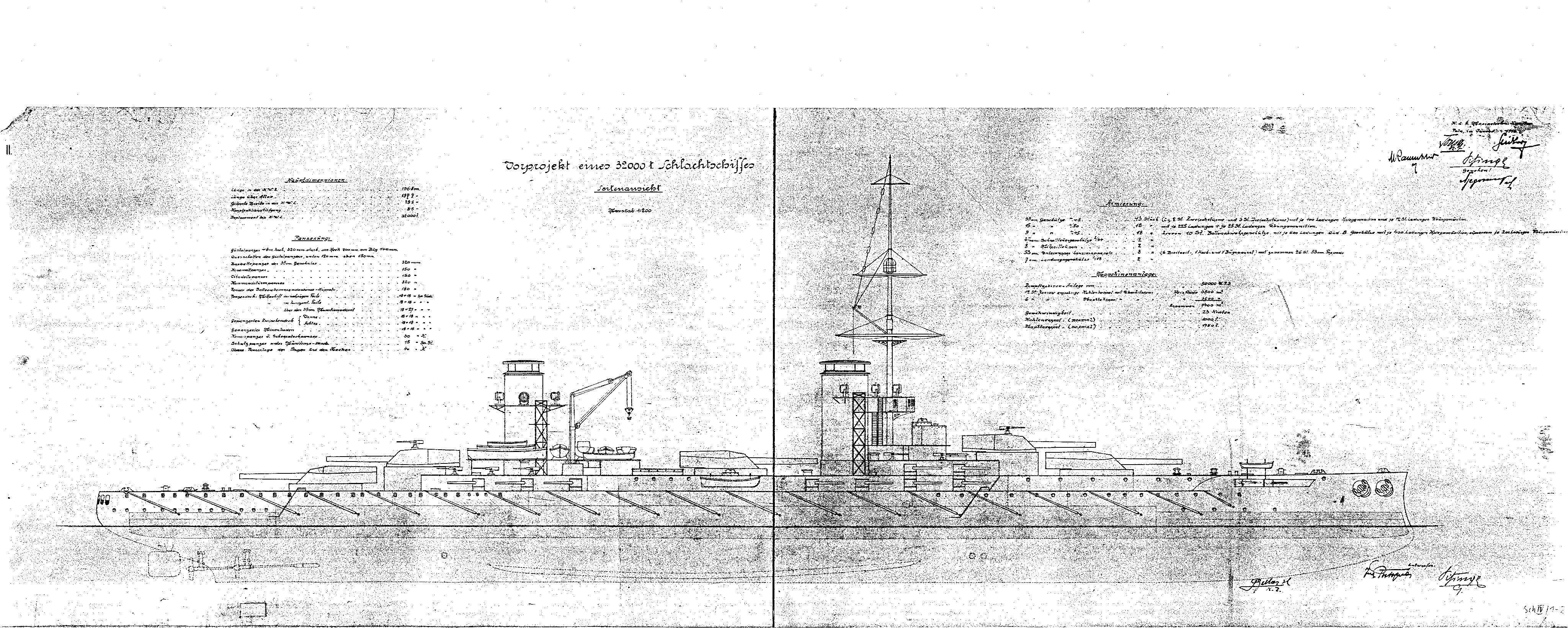Preliminary Designs - Ersatz Monarch Class
Illustration and Text by Takács Zoltán
| |
Ersatz Monarch Preliminary Designs I-VIII
While the Ersatz Monarch class battleships is mostly likely the most well-known never-were project of the Austro-Hungarian Navy (Kaiserlich und Königlich Kriegsmarine), the history of the class and the other design variants considered are rather difficult to get knowledge of. Not only because the troubled history of the Austro-Hungarian Empire and its successor states (Ships designed by Vienna and the various shipyards of Croatia and parts of nowadays Italy, Armour produced by Vitkovice in Silesia and Main guns produced and developed by Skoda in Bohemia (today Czech Republic), while engines and smaller calibre guns produced by Ganz-Danubius, Budapest, Hungary) in the past 100 years, but the documents of the ships might ended up in various parts of the old Monarch due to their contribution of the development and construction of the ships. Meaning while most of the documents were held in Vienna (Austria), some documents could be found in Budapest (Hungary), Pola and Zagreb (Croatia), Venezia (Italy) or might be even in Prague (Czech Republic). None the less due to some Hungarian and Italian Naval enthusiasts as well as sheer luck I was able to collect as much info as I could.
In case of the name formally this new class of battleships were never called Ersatz Monarch class, but rather as Projects like I, II, III etc., Enlarged or Improved Tegetthoff type or by their tonnage like 23.400ton battleships, 24.500ton battleships and so on. The name Ersatz Monarch (Replacement Monarch) originated from the leading article of August 1913 number of “Die Flagge”, the monthly magazine of Austrian Navy League: “The Monarch class must be replaced.” and hence the name Ersatz Monarch survived to this very day describing the last ordered battleships of the Austro-Hungarian Navy.
In early June 1911, some 3 weeks before the launch of SMS Viribus Unitis (First dreadnought battleship of Austro-Hungary) planning works begun for a new design of battleship. The Empire required new battleships for several reasons:
- Balance the eternal rival of the Adriatic Region: Italy’s construction of new battleships (Andrea Doria and Conte di Cavour classes);
- With the addition of modern capital ships, the fleet of Austria-Hungary became a major navy instead of a mere coastal defence force;
- To maintain the status of great power was impossible without dreadnought-type battleships
The new battleships must be stronger than the previous Viribus Unitis class and for better sea-keeping abilities must have a risen forecastle deck and increased speed of 21knots (39km/h)
With other requirements as follows:
- Variant A: 23.000tons, with a minimum of 10x 30,5 cm cannons, 18x 15cm and 24x 7,5 cm secondary and tertiary guns
- Variant B: 24.600tons, with a minimum of 10x 34,5 cm cannons, other armament same as above
The displacement was limited by the lifting capacity of Drydock No.1 of 23.800tons.
In April earlier of that year, Skoda offered plans of a new heavy gun a 34,5cm one in twin and triple turrets as well as ideas for a new battleship arguing with the necessity of securing high skilled workforce and ensuring development continuity.
The Naval Technical Committee (MTK - Marinetechnische Komitee) offered the first designs in December of that year:
- Project I: 22.000tons, 4x3, 30,5cm, 16x1 15cm, 18x1 7,5cm
- Project II: 23.400tons, 2x3,2x2 34,5cm, 6x2,10x1 15cm, 24x1 7,5cm
- Project III: 24.500tons, 2x3,2x2 34,5cm, 6x2,10x1 15cm, 24x1 7,5cm
- Project IV: 23.400tons, 2x3,2x2 34,5cm, 6x2,10x1 15cm, 24x1 7,5cm
All had 6x 53cm Underwater Torpedo tubes
With Project I modified (as Project V) in February of the next year with partially reduced poop deck (which might be more of a partially reduced quarter or aft deck as poop deck was not used on any modern capital ships!) to reduce the displacement of the design after more accurate calculations were done. Another unique traits of these proposals are the usage of twin casemates required by the specified large amount of secondary guns on a limited hull length. Further investigations in the twin casemate design, while featured better gun placements on a limited hull the actual technical difficulties of placing two guns in a single casemate as well as the issues of reloading and rotating the mount resulting of rejection of the idea. (Note: Twin casemates were offered by STT (Stabilimento Tecnico Triestino - Technical Establishment of Trieste) for the Viribus Unitis class as well in 1909! as shown by official papers)
The 7,5cm/50 gun was a new development which did not entered production but it was in par with the other navies 76mm or 3” guns used mostly for Anti-Torpedo Boat, Anti-Destroyer and Anti-Air weaponry and would had provided better protection for the ships than the previous 7cm (66mm) guns. Later the 7,5cm L/30 K16 gun developed by Skoda was used onboard submarines, destroyers (Warasdiner, Huszár class) and gunboats as AA guns and might had been developed from this earlier 7,5cm gun.
To counter the influence of Skoda, the Naval Ministry ordered a new set of designs in early spring of 1912 with armaments minimum of 8x either 34,5cm or 35,5cm cannons (Skoda was ordered to develop guns and turrets for this new calibre as well) with new tonnage set to 23.400tons. Though Skoda could not provide drawings and data of the 35,5cm guns and turrets in time so most of the Shipyards used 34,5cm guns for their proposals.
With this new specifications in mind no less than 26 design proposals were made by the various shipyards ranging from 8 guns to 13 guns, from 161 to 175m in length, displacements of 23.400 to 27.000tons and armour ranging from 280mm to 340mm belt and 38-64mm deck. Sadly most of these designs precise data as well as their drawings I could not acquire (if still exists) and hence I only draw the MTK variants for which I have more accurate data of.
In case of the 8 gunned 23.000ton designs I’m not sure the accuracy of either the tonnage or the amount of guns carried because on 23-24.000tons the Royal Navy able to produce ships: Orion and King George V class, HMS Erin with 5x2 343mm (13,5”) armament on a same hull size and belt armour but thicker deck armour and faster speed of 22knots.
Here is the list of designers who offered their ideas to the Naval Ministry apart from MTK:
- CNT - Cantiere Navale Triestino (Trieste Naval Shipyard)
- STT - Stabilimento Tecnico Triestino (Technical Establishment of Trieste) mostly by Naval Architect Siegfried Popper
- Ganz-Danubius - Ganz és Társa-Danubius Villamossági-, Gép-, Waggon- és Hajógyár Rt. (Ganz and Partner-Danubius Electrical-Machine-, Wagon- and Shipbuilding Co.)
- Naval Architect Silvius Morin
None the less by May 1912 MTK proposed these new set of designs all of which of 25.200tons displacement:
- Project VI: 1x3,4x2 34,5cm, 16x1 15cm, 18x1 7,5cm
- Project VII: 4x3 34,5cm, 16x1 15cm, 18x1 7,5cm
- Project VIII: 3x3,2x2 34,5cm, 16x1 15cm, 18x1 7,5cm
- Project IX: 2x3,3x2 34,5cm, 14x1 15cm, 18x1 7,5cm
All had 6x Underwater 53cm Torpedo Tubes
| |
Design I (December 1911)
| Item | Description |
| Dimension: | 161 (wl), 162,2 (oa) x 27,6 x 8,4m |
| Displacement: | 22.000tons (standard) |
| Armour: | 300mm Belt 63mm Deck |
| Engines: | 28.000shp Steam Turbines, 4 shafts |
| Speed: | 39km/h (21knots) |
| Armament: | 4x3 30,5cm 6x2,10x1 15cm Casemated Guns 24x1 7,5cm Guns 6x1 53cm Underwater Torpedo tubes |
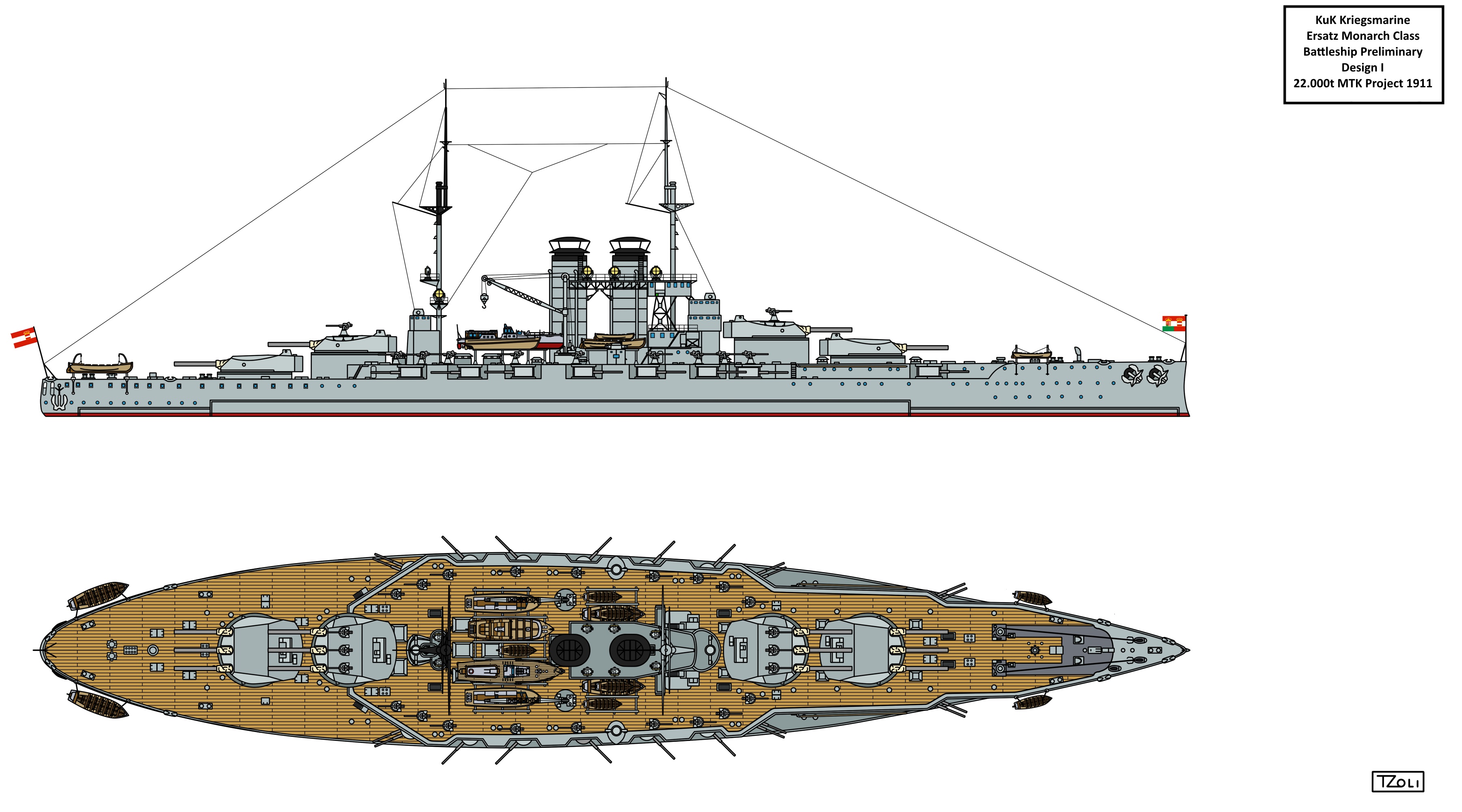
| |
Design II (December 1911)
| Item | Description |
| Dimension: | 165 (wl), 166,2 (oa) x 27,8 x 8,4m |
| Displacement: | 23.400tons (standard) |
| Armour: | 300mm Belt 76mm Deck |
| Engines: | 30.000shp Steam Turbines, 4 shafts |
| Speed: | 39km/h (21knots) |
| Armament: | 2x3,2x2 34,5cm 6x2,10x1 15cm Casemated Guns 24x1 7,5cm Guns 6x1 53cm Underwater Torpedo tubes |
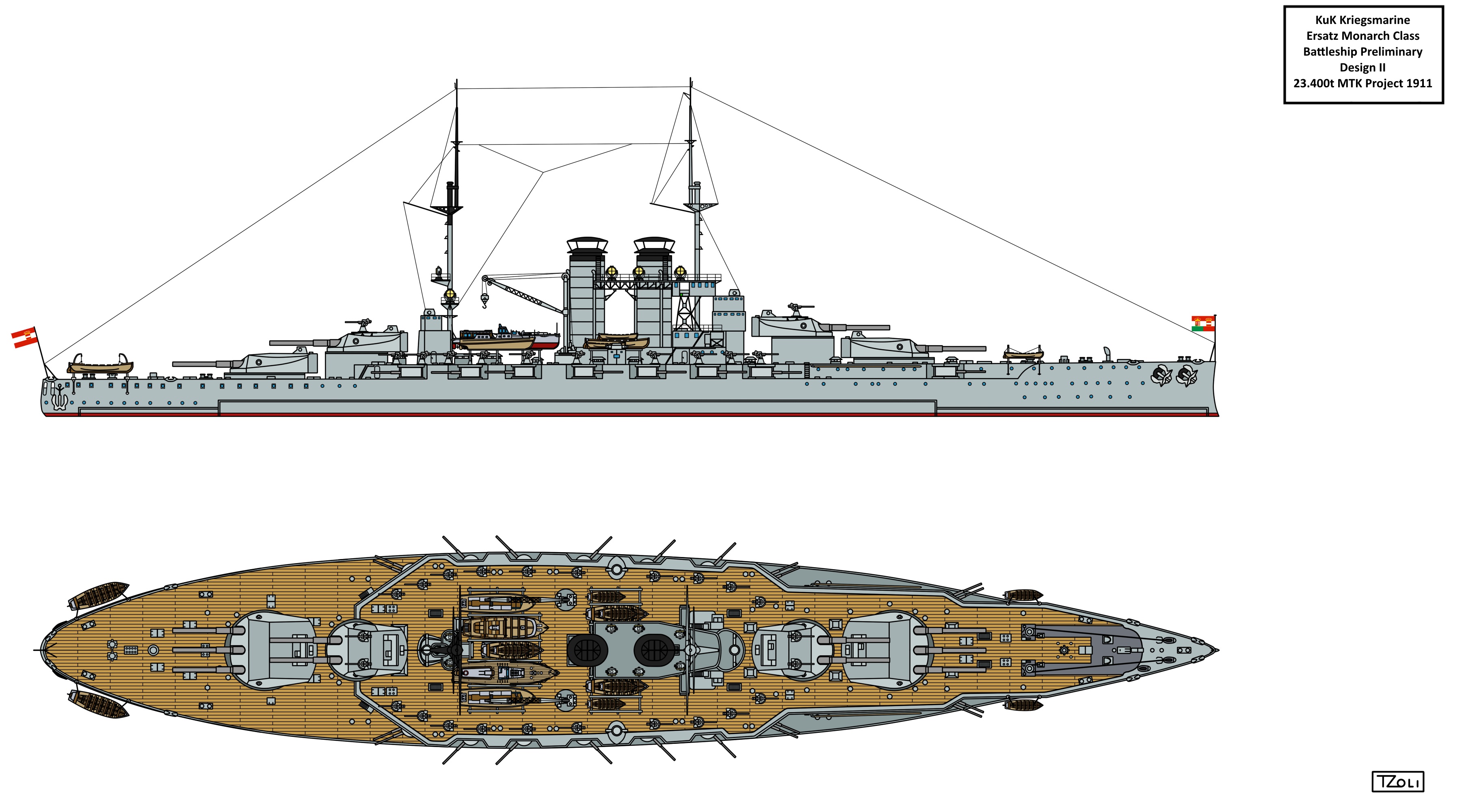
| |
Design III (December 1911)
| Item | Description |
| Dimension: | 165 (wl), 166,2 (oa) x 27,8 x 8,4m |
| Displacement: | 24.500tons (standard) |
| Armour: | 320mm Belt 63mm Deck |
| Engines: | 30.000shp Steam Turbines, 4 shafts |
| Speed: | 39km/h (21knots) |
| Armament: | 2x3,2x2 34,5cm 6x2,10x1 15cm Casemated Guns 24x1 7,5cm Guns 6x1 53cm Underwater Torpedo tubes |
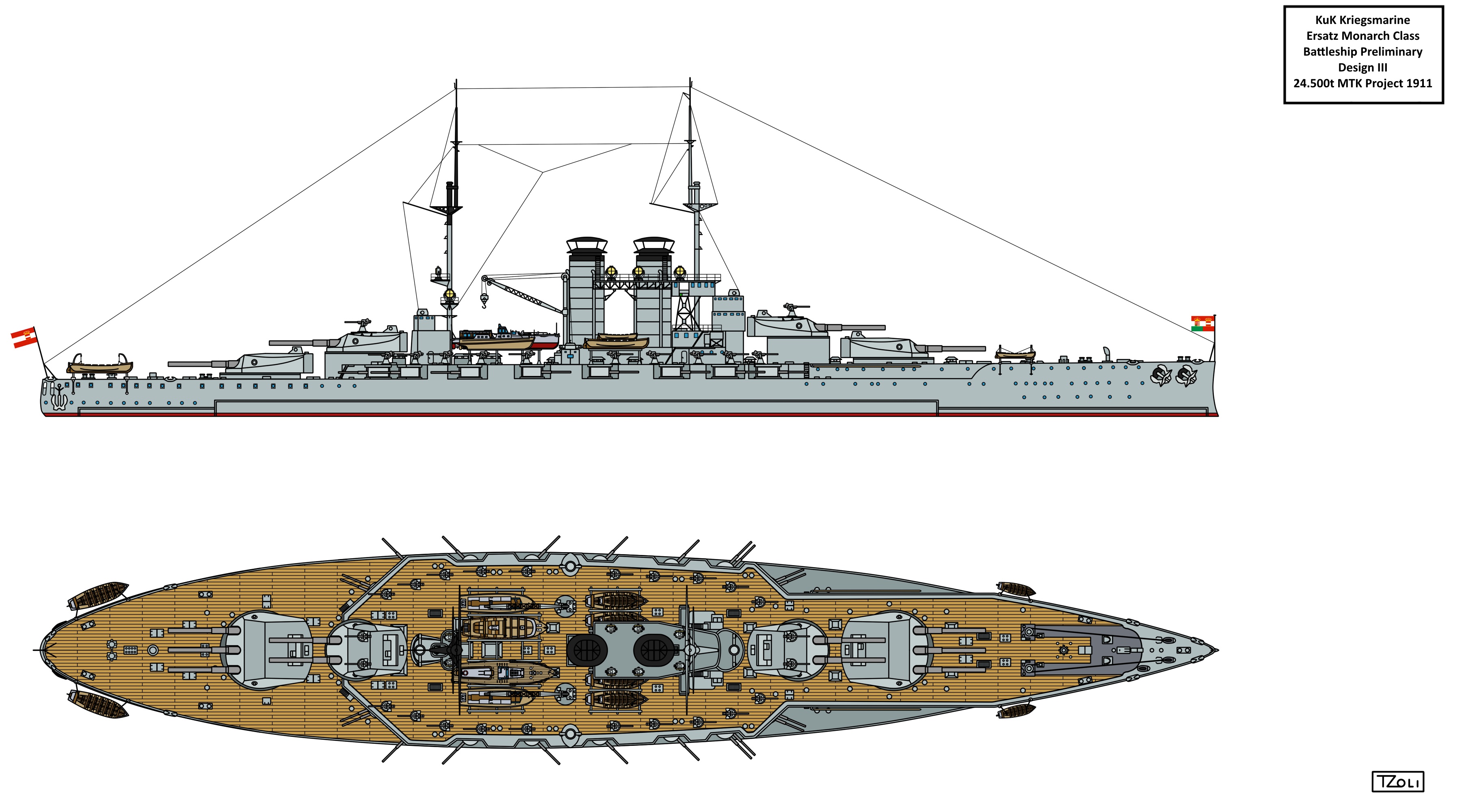
| |
Design IV (December 1911)
| Item | Description |
| Dimension: | 165 (wl), 166,2 (oa) x 27,8 x 8,4m |
| Displacement: | 23.400tons (standard) |
| Armour: | 300mm Belt 76mm Deck |
| Engines: | 30.000shp Steam Turbines, 4 shafts |
| Speed: | 39km/h (21knots) |
| Armament: | 2x3,2x2 34,5cm 6x2,10x1 15cm Casemated Guns 24x1 7,5cm Guns 6x1 53cm Underwater Torpedo tubes |
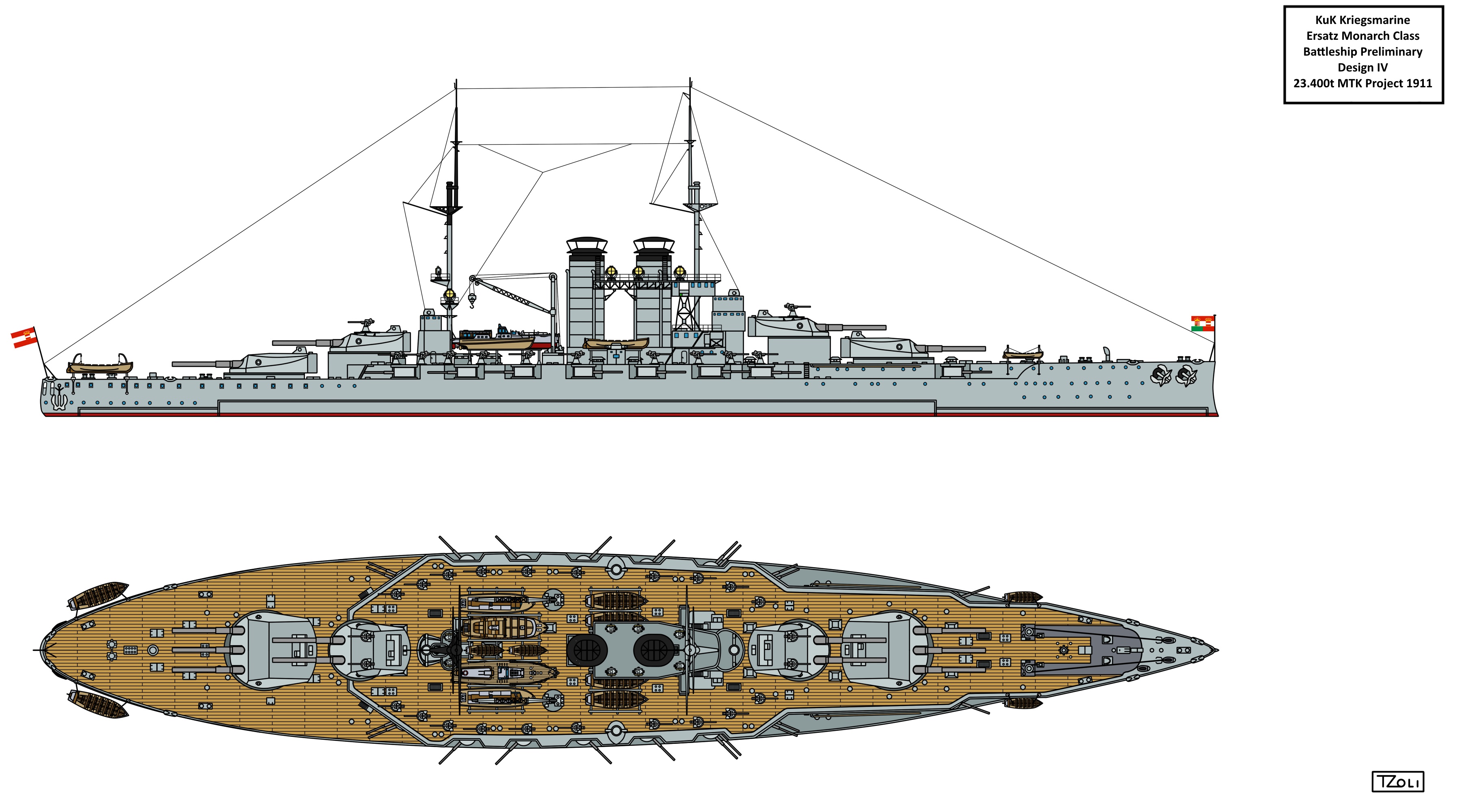
| |
Design V (February 1912)
| Item | Description |
| Dimension: | 161 (wl), 162,2 (oa) x 27,6 x 8,4m |
| Displacement: | 22.000tons (standard) |
| Armour: | 300mm Belt 63mm Deck |
| Engines: | 28.000shp Steam Turbines, 4 shafts |
| Speed: | 39km/h (21knots) |
| Armament: | 4x3 30,5cm 6x2,10x1 15cm Casemated Guns 24x1 7,5cm Guns 6x1 53cm Underwater Torpedo tubes |
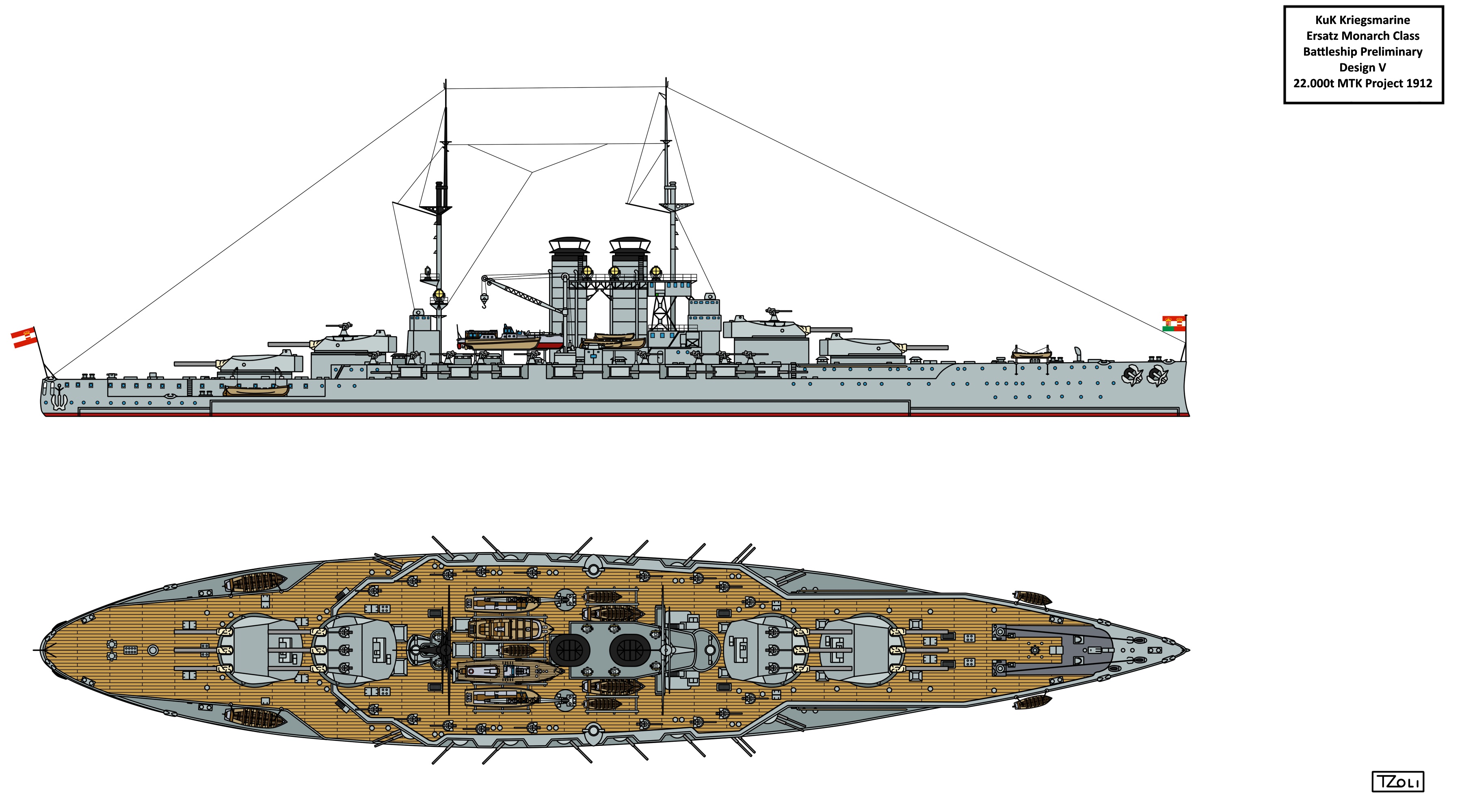
| |
Design VI (May 1912)
| Item | Description |
| Dimension: | 175 (wl), 176,2 (oa) x 28,5 x 8,6m |
| Displacement: | 25.200tons (standard) |
| Armour: | 340mm Belt 76mm Deck |
| Engines: | 30.000shp Steam Turbines, 4 shafts |
| Speed: | 39km/h (21knots) |
| Armament: | 1x3,4x2 34,5cm 16x1 15cm Casemated Guns 18x1 7,5cm Guns 6x1 53cm Underwater Torpedo tubes |
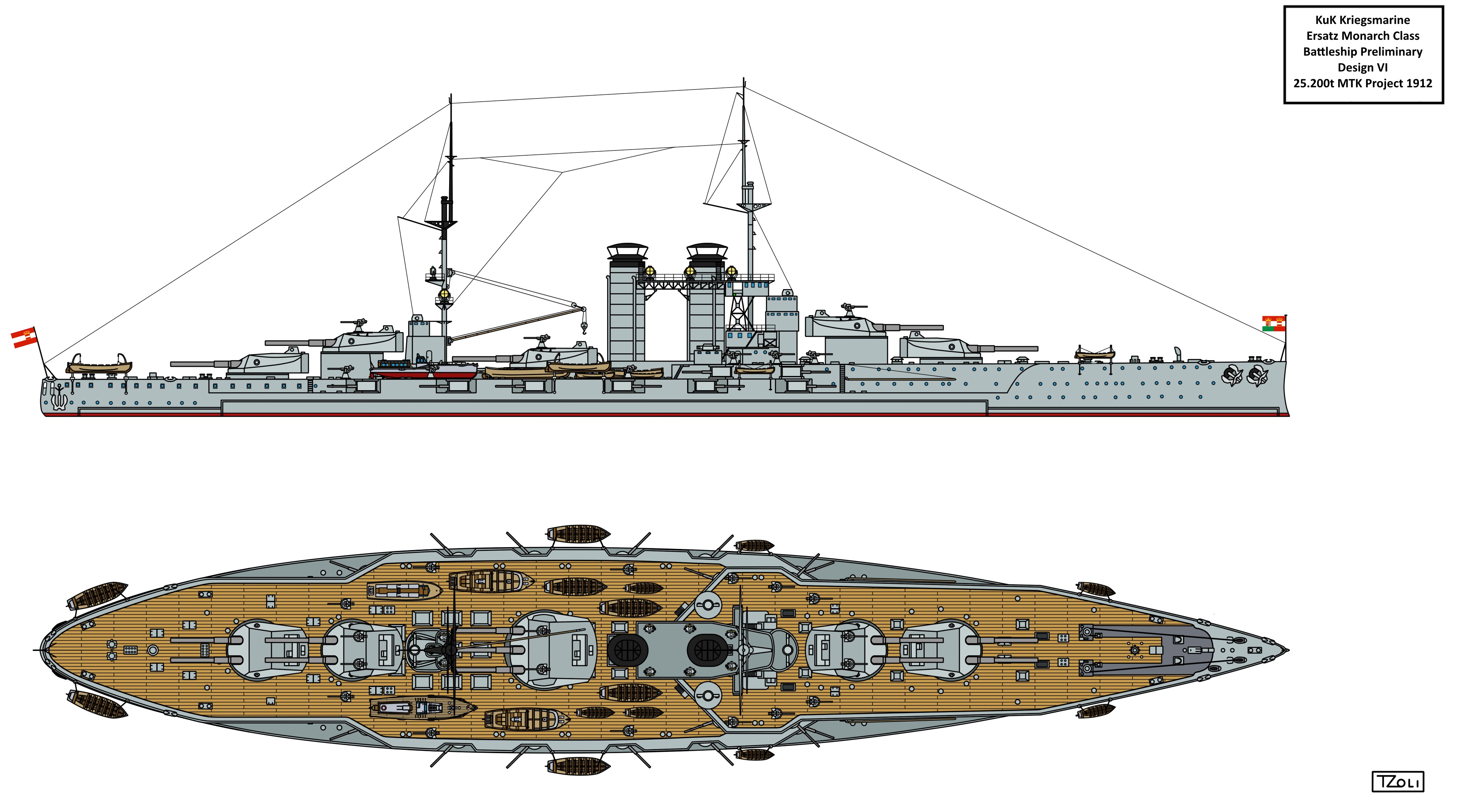
| |
Design VII (May 1912)
| Item | Description |
| Dimension: | 175 (wl), 176,2 (oa) x 28,5 x 8,6m |
| Displacement: | 25.200tons (standard) |
| Armour: | 340mm Belt 76mm Deck |
| Engines: | 30.000shp Steam Turbines, 4 shafts |
| Speed: | 39km/h (21knots) |
| Armament: | 4x3 34,5cm 16x1 15cm Casemated Guns 18x1 7,5cm Guns 6x1 53cm Underwater Torpedo tubes |
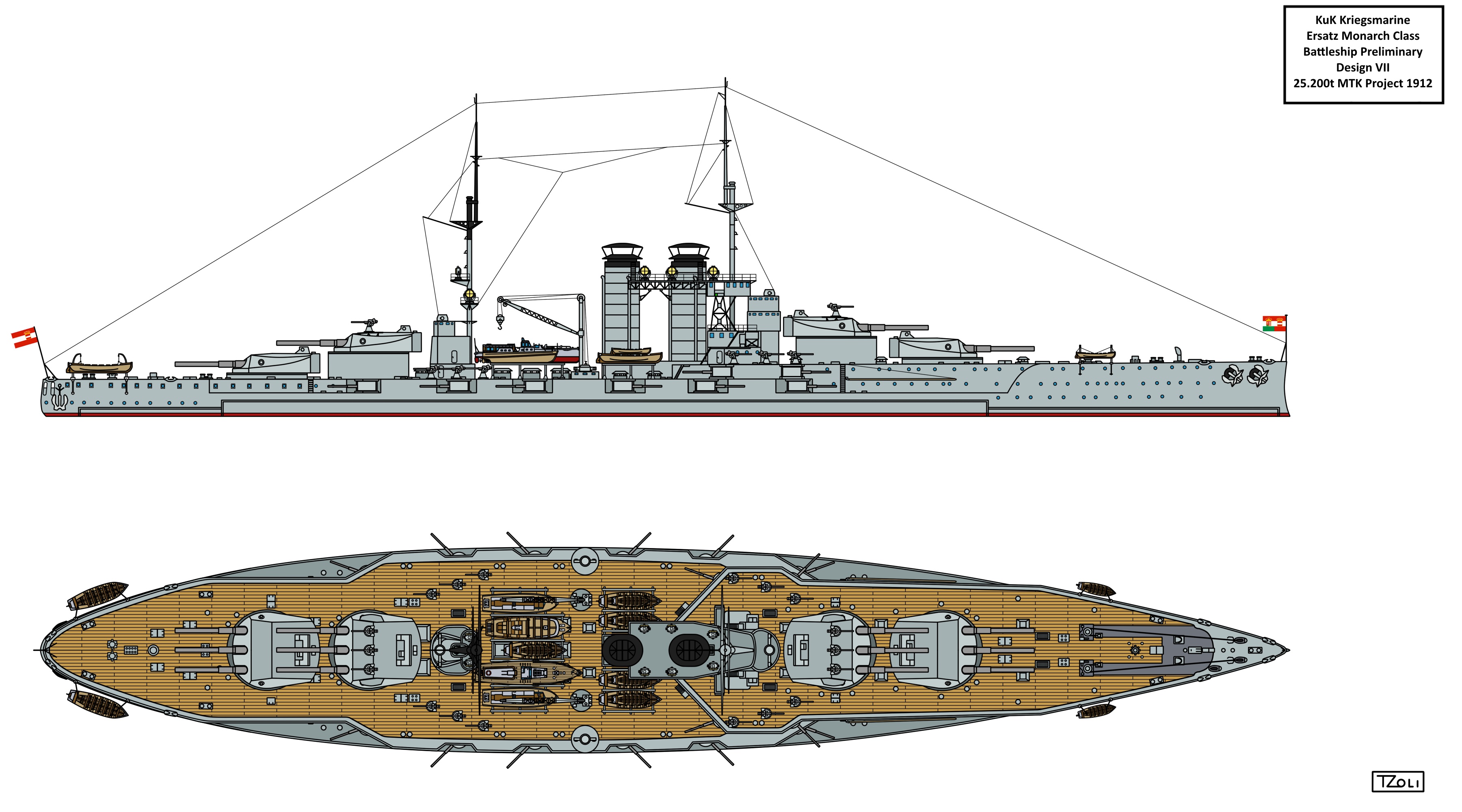
| |
Design VIII (May 1912)
| Item | Description |
| Dimension: | 175 (wl), 176,2 (oa) x 28,5 x 8,6m |
| Displacement: | 25.200tons (standard) |
| Armour: | 340mm Belt 76mm Deck |
| Engines: | 30.000shp Steam Turbines, 4 shafts |
| Speed: | 39km/h (21knots) |
| Armament: | 3x3,2x2 34,5cm 16x1 15cm Casemated Guns 18x1 7,5cm Guns 6x1 53cm Underwater Torpedo tubes |
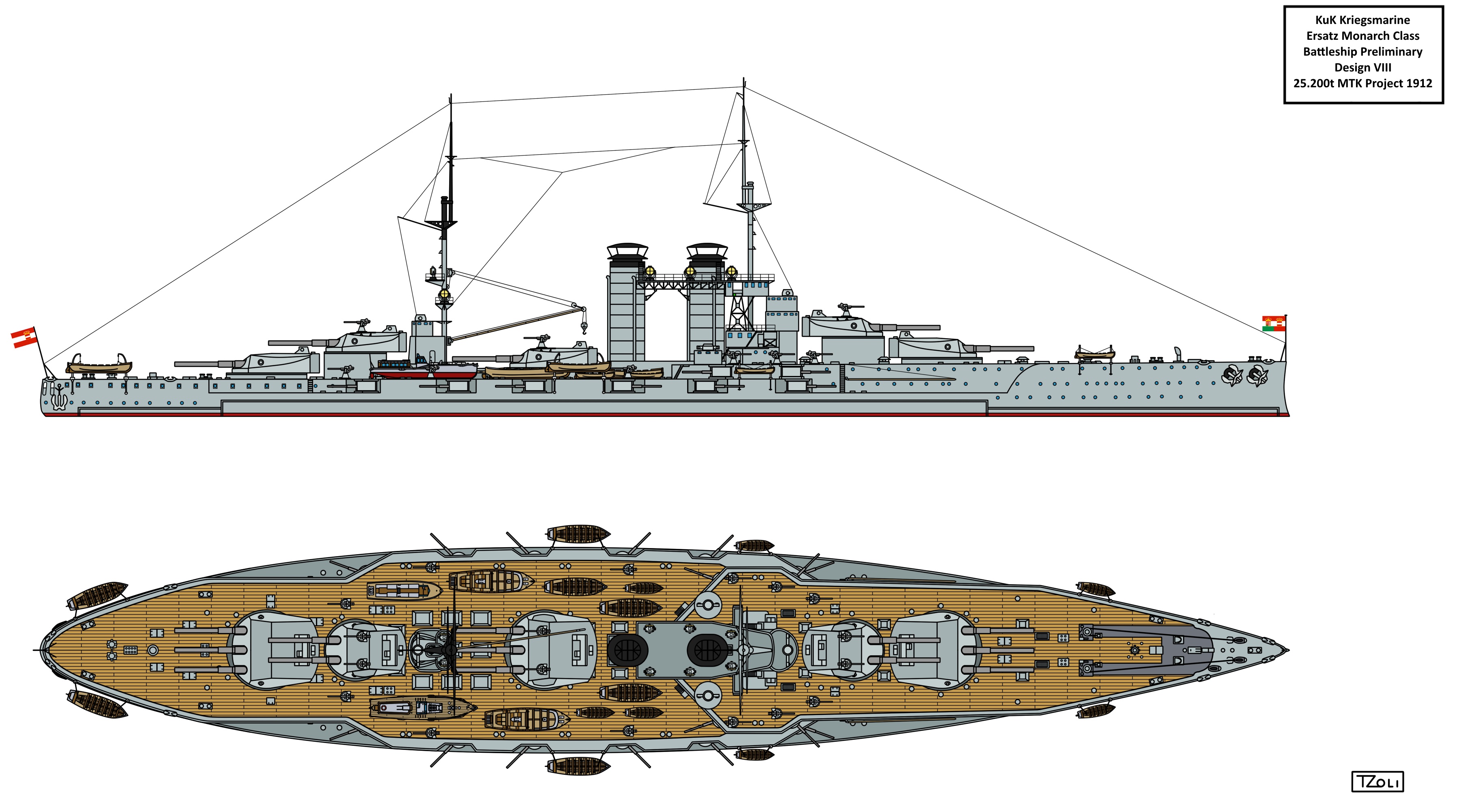
| |
Ersatz Monarch Preliminary Designs IX-XVI
After the last series of 34,5cm armed battleship designs were offered to the navy, the Ministry held a meeting in June 1912 to discuss the various proposals. On the meeting headed by Vice-Admiral Karl Kailer von Kaltenfels and chief naval architect Franz Pitzinger was also present who briefly commented on all the designs. By early July of 1912 the meeting concluded the following:
- 23.400 tons of displacement were too small for a well designed battleship and thus 24.500tons of displacement was chosen
- A new set of gun calibre was chosen: 35cm (Minimum 10 guns) as the final calibre which could use a standardised shell then under development by Krupp and the Imperial German Navy
- 18x 15cm secondary guns
- 9cm (88mm) tertiary guns
- Minimunm of 300mm Belt armour
- Minimum of 21knots speed
After these new set of requirements were formalised, the 3 shipyards were asked again but sadly I have only info on the MTK proposals as well as a single design from Ganz-Danubius. The Ganz-Danubius proposal is a bit different from the other designs as it was shorter but beamer resulting in a more stable gun platform but required a stronger engine due to the worse beam to length ratio and would had a single funnel. The MTK proposals were preferred and most have two versions done: one with superfiring triple the other with superfiring twin turrets also introducing casemates on two levels front to maximize forward fire.
While the Naval Ministry preferred superfiring twin turrets as they know the results of the trials done by SMS Viribus Unitis and SMS Tegetthoff which showed that these ships were top heavy (which is more about maximum weaponry on a limited displacement as Viribus Unitis class was the smallest battleship design which could carry 12x 30,5cm cannons) still the designers offered superfiring triple turrets as these showed better lines for the curves of the hull front and aft and also reduced citadel width which was also saving tonnage. On the other hand superfiring twin turrets would result in a more stable gun platform due to the less topweight the twin turrets offered.
The new designs were finished by January 1913 with Ganz Danubius's proposal by March:
- Project X: 24.500tons, 2x3,2x2 35cm, 18x1 15cm, 16x1 9cm, 6x1 9cm AA, 6x 53cm Underwater Torpedo tubes
- Project XI: 24.500tons, 2x3,2x2 35cm, 18x1 15cm, 16x1 9cm, 4x1 9cm AA, 6x 53cm Underwater Torpedo tubes
- Project XII: 24.650tons, 2x3,2x2 35cm, 18x1 15cm, 16x1 9cm, 4x1 9cm AA, 6x 53cm Underwater Torpedo tubes
On 23rd April 1913 the Command of the Navy ordered the NTC to rework the January 1913 design: after some weight saving modifications it had to thicken the armour of the belt, the barbettes and the conning tower. In addition, it had to completely redesign the electric system of the ship and thus Project XI was born.
Apparently the Austro-Hungarian naval architects felt that such stripped down designs would not be well balanced and presented two enlarged alternative designs with heavier weaponry and speed increment to 23knots in January 1914, showing that more displacement was required for a more balanced battleships. These two designs are:
- Project XIII / Pre-project I: 29.600tons, 4x3 35cm, 18x1 15cm, 8x1 9cm, 10x1 9cm AA, 6x 53cm Underwater Torpedo tubes
- Project XIV / Pre-project II: 32.000tons, 3x3,2x2 35cm, 18x1 15cm, 8x1 9cm, 10x1 9cm AA, 8x 53cm Underwater Torpedo tubes
These two were of course not chosen due to the building limitations of the shipyard facilities, but a 40.000ton Floating dock was ordered from Germany just before WW1 broke out. But the tonnage limit was kept upright so in July 1914 the last design variants was presented. For weight reasons the number of secondary guns was reduced to 14x 15cm and tonnage set at 24.560tons:
- Project XV: 24.560tons, 2x3,2x2 35cm, 14x1 15cm, 10x1 9cm, 12x1 9cm AA, 6x 53cm Underwater Torpedo tubes
- Final Project / Project XVI: 24.560tons, 2x3,2x2 35cm, 14x1 15cm, 8x1 9cm, 12x1 9cm AA, 6x 53cm Underwater Torpedo tubes
Due to some copyright issues I can only provide links to the the plans of the 1913 project ( Project X ):
But I had access to the original plans of the Final Project and the two enlarged Pre-Projects as well, for others I had only data from the Viribus Unitis site http://www.viribusunitis.ca/
And from friends.
| |
Design IX (May 1912)
| Item | Description |
| Dimension: | 175 (wl), 176,2 (oa) x 28,5 x 8,5m |
| Displacement: | 25.200tons (standard) |
| Armour: | 340mm Belt 76mm Deck |
| Engines: | 30.000shp Steam Turbines, 4 shafts |
| Speed: | 39km/h (21knots) |
| Armament: | 2x3,3x2 34,5cm 14x1 15cm Casemated Guns 16x1 9cm Guns 18x1 7,5cm Guns 6x1 53cm Underwater Torpedo tubes |
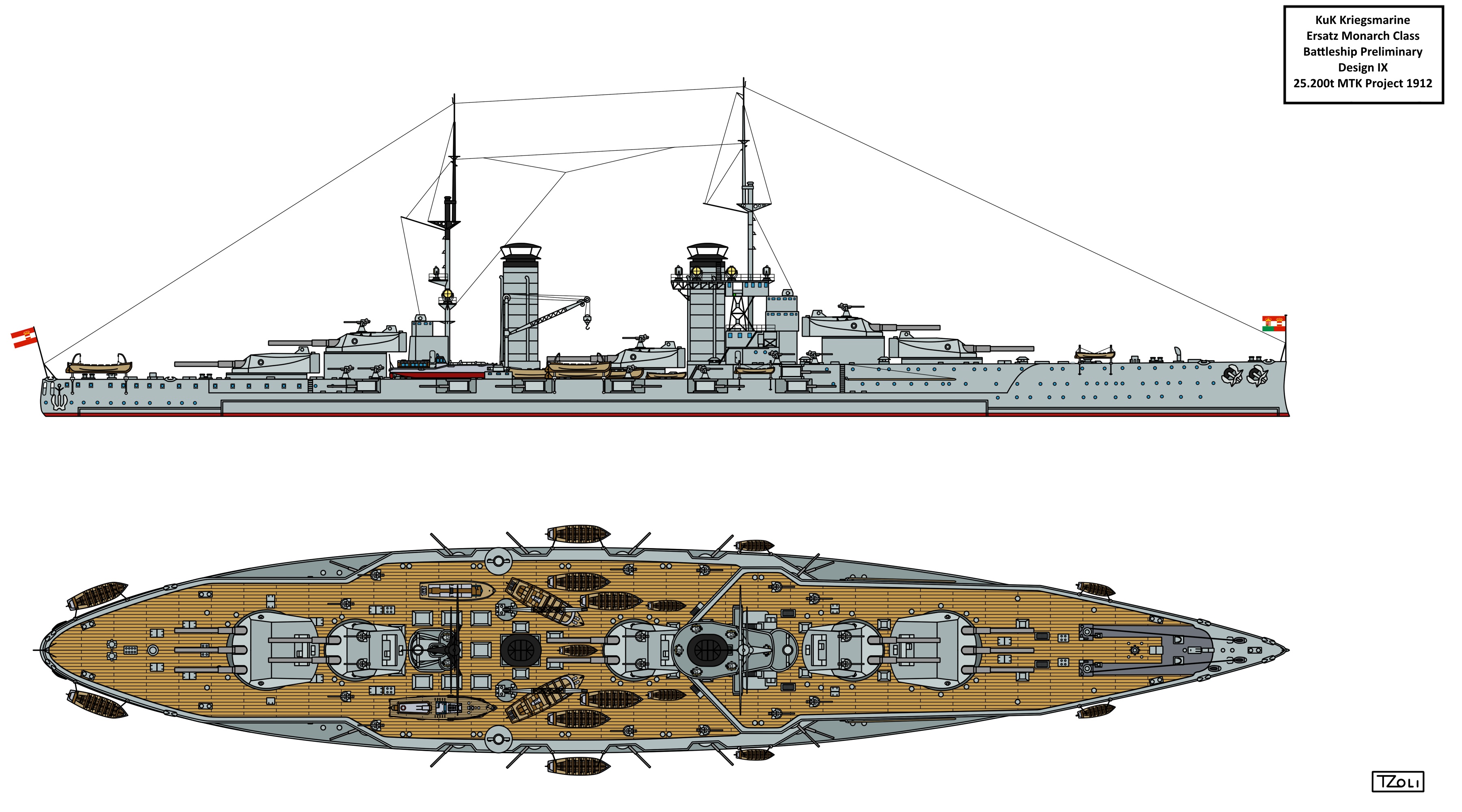
| |
Design X (January 1913)
| Item | Description |
| Dimension: | 172 (wl), 173,2 (oa) x 28,5 x 8,4m |
| Displacement: | 24.500tons (standard) |
| Armour: | 320mm Belt 72mm Deck |
| Engines: | 31.000shp Steam Turbines, 4 shafts |
| Speed: | 39km/h (21knots) |
| Armament: | 2x3,2x2 35cm 16x1 15cm Casemated Guns 16x1 9cm Guns 6x1 9cm AA Guns 6x1 53cm Underwater Torpedo tubes |
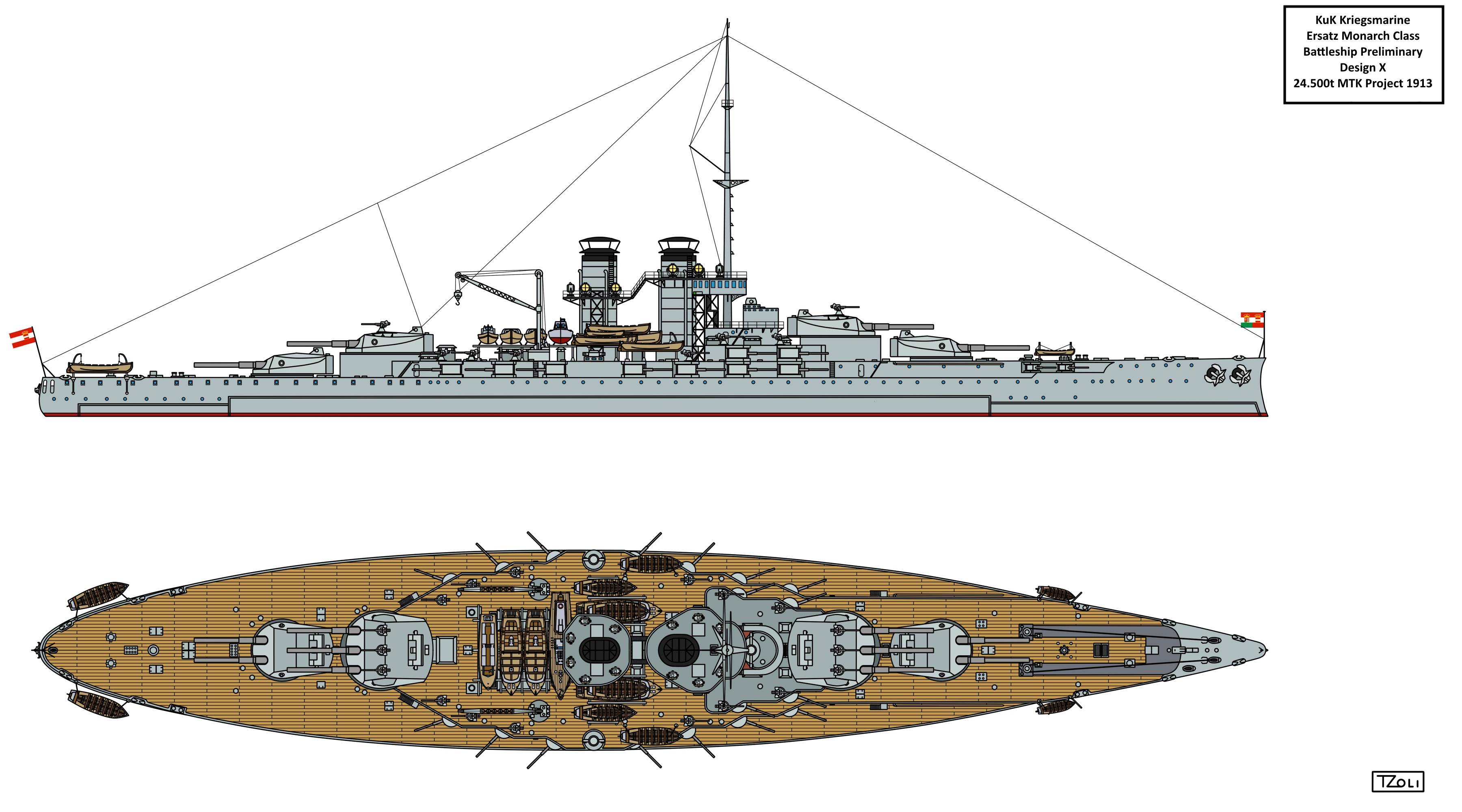
| |
Design XI (April 1913)
| Item | Description |
| Dimension: | 172 (wl), 173,2 (oa) x 28,5 x 8,4m |
| Displacement: | 24.500tons (standard) |
| Armour: | 320mm Belt 72mm Deck |
| Engines: | 31.000shp Steam Turbines, 4 shafts |
| Speed: | 39km/h (21knots) |
| Armament: | 2x3,2x2 35cm 16x1 15cm Casemated Guns 16x1 9cm Guns 4x1 9cm AA Guns 6x1 53cm Underwater Torpedo tubes |
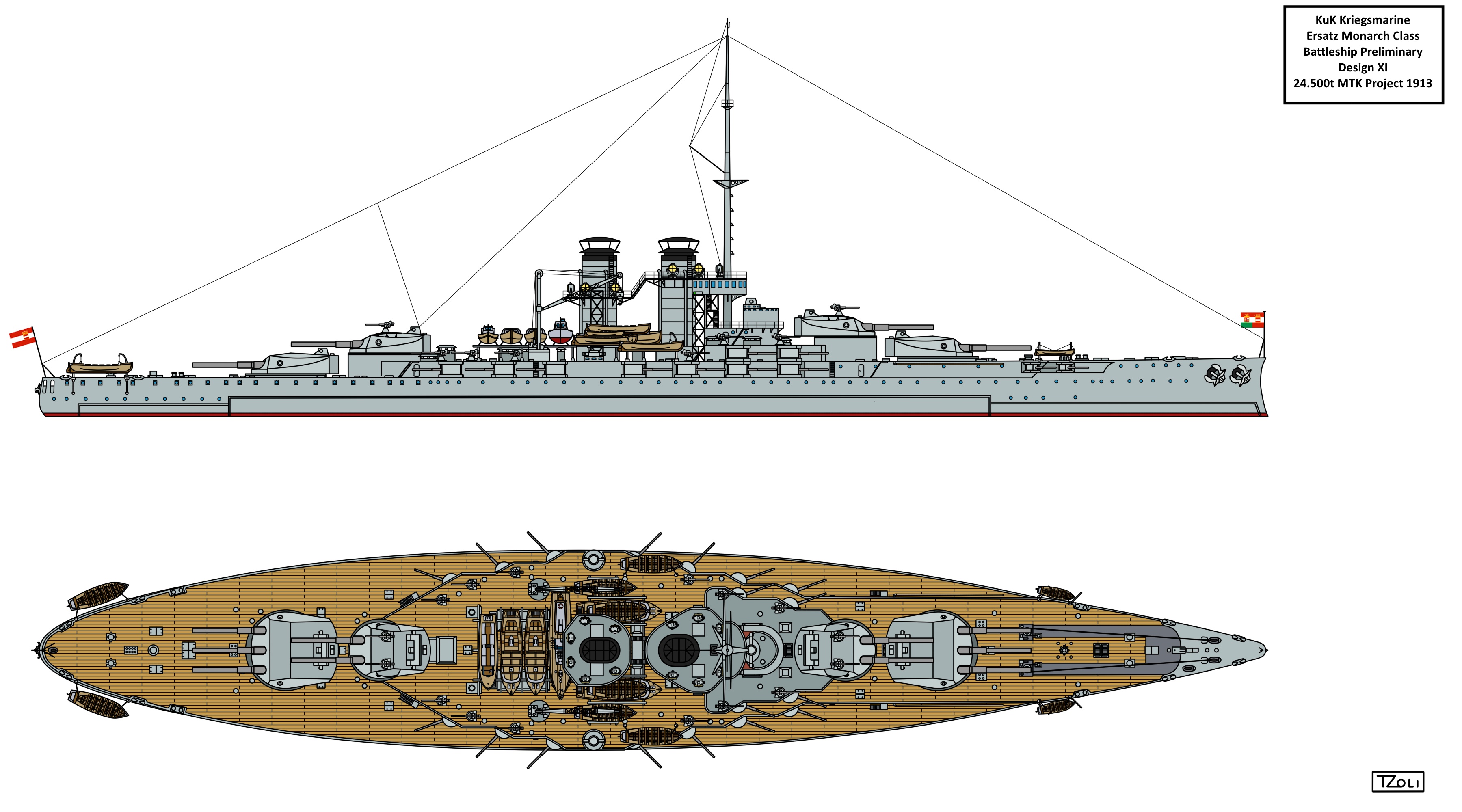
| |
Design XII Pre-project (Ganz-Danubius Project) (January 1914)
| Item | Description |
| Dimension: | 165 (wl) x 29,2 x 8,3m |
| Displacement: | 24.650tons (standard) |
| Armour: | 300mm Belt 63mm Deck |
| Engines: | 32.000shp Steam Turbines, 4 shafts |
| Speed: | 39km/h (21knots) |
| Armament: | 2x3,2x2 35cm 16x1 15cm Casemated Guns 16x1 9cm Guns 4x1 9cm AA Guns 6x1 53cm Underwater Torpedo tubes |
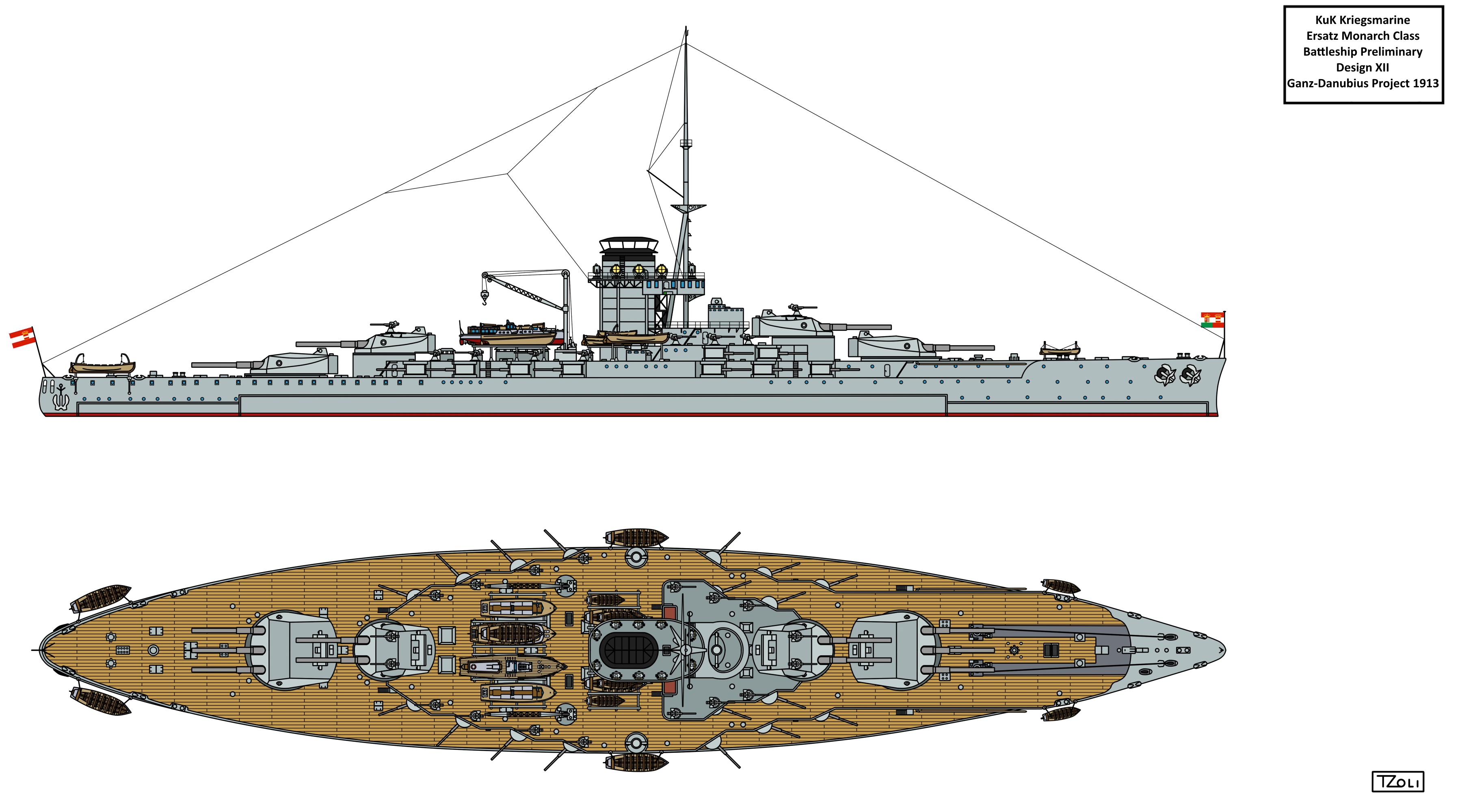
| |
Design XIII Pre-project (January 1914) - STT Project I
| Item | Description |
| Dimension: | 194 (wl), 195,2 (oa) x 29 x 8,5m |
| Displacement: | 29.600tons (standard) |
| Armour: | 320mm Belt 72mm Deck |
| Engines: | 45.000shp Steam Turbines, 4 shafts |
| Speed: | 43km/h (23knots) |
| Armament: | 4x3 35cm 16x1 15cm Casemated Guns 8x1 9cm Guns 10x1 9cm AA Guns 6x1 53cm Underwater Torpedo tubes |
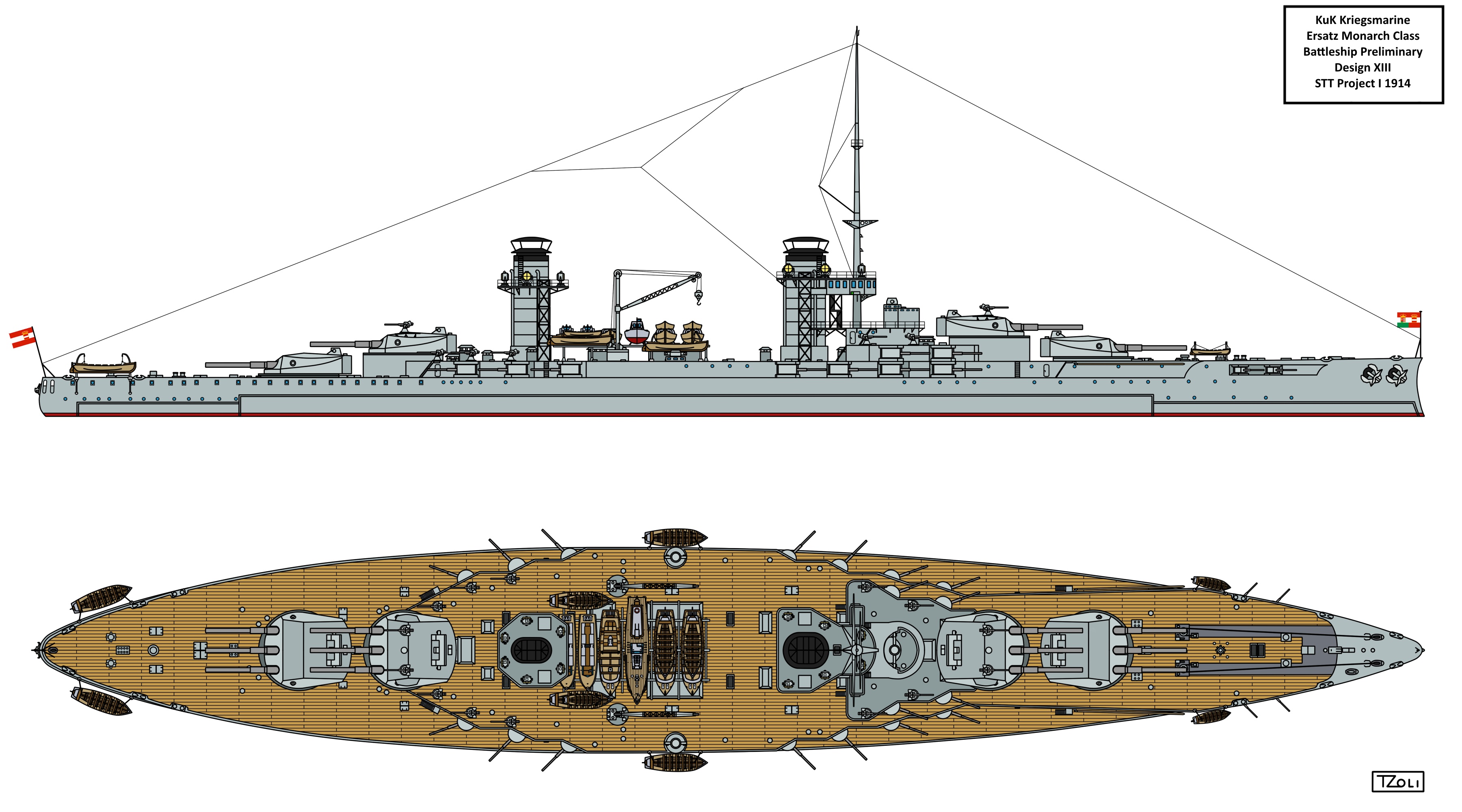
| |
Design XIV (January 1914) - STT Project II
| Item | Description |
| Dimension: | 196,5 (wl), 197,8 (oa) x 29,5 x 8,4m |
| Displacement: | 32.000tons (standard) |
| Armour: | 320mm Belt 72mm Deck |
| Engines: | 50.000shp Steam Turbines, 4 shafts |
| Speed: | 43km/h (23knots) |
| Armament: | 3x3,2x2 35cm 16x1 15cm Casemated Guns 8x1 9cm Guns 10x1 9cm AA Guns 8x1 53cm Underwater Torpedo tubes |
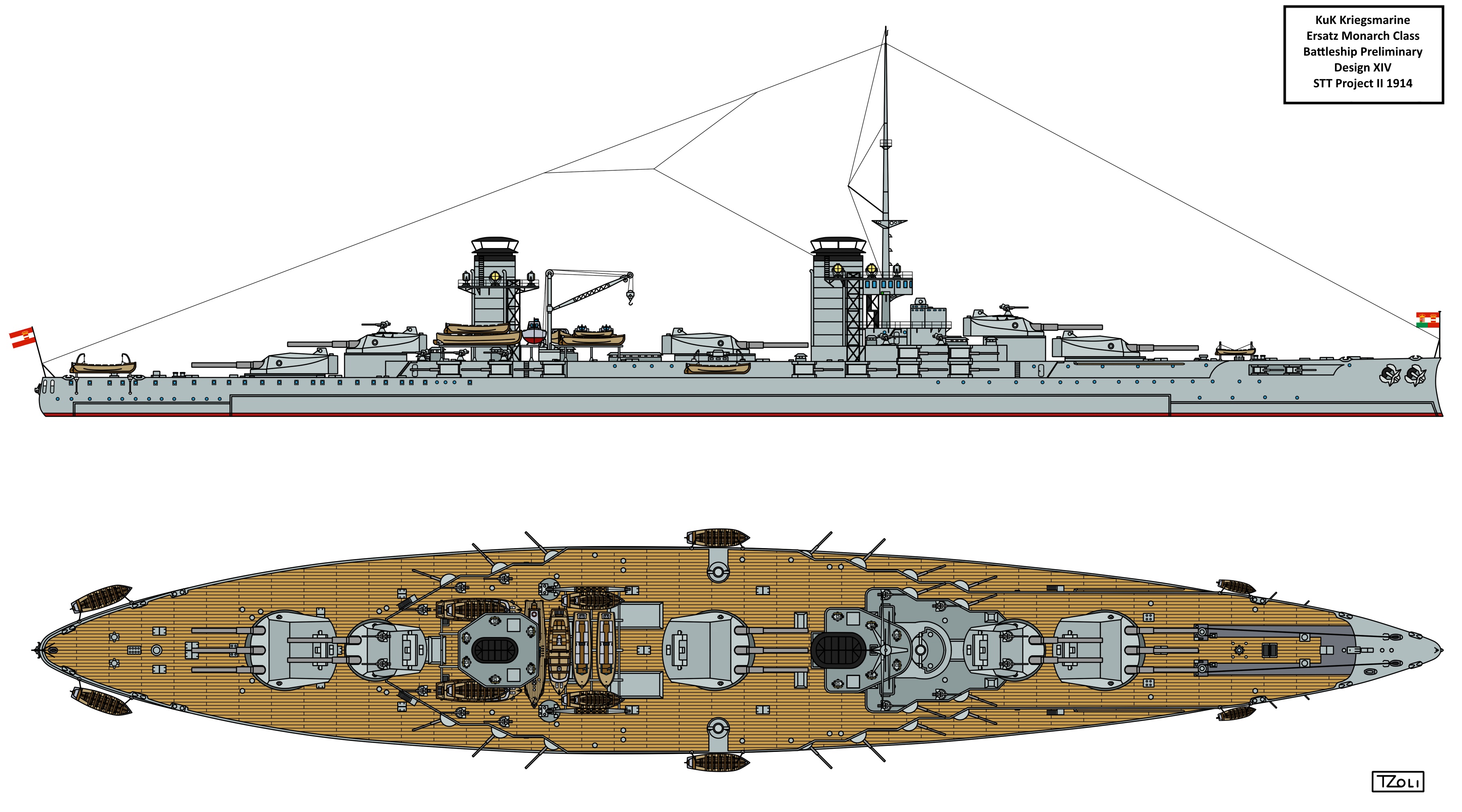
| |
Design XV (July 1914)
| Item | Description |
| Dimension: | 172 (wl), 173,2 (oa) x 28,5 x 8,4m |
| Displacement: | 24.560tons (standard) |
| Armour: | 310mm Belt 72mm Deck |
| Engines: | 31.000shp Steam Turbines, 4 shafts |
| Speed: | 39km/h (21knots) |
| Armament: | 2x3,2x2 35cm 14x1 15cm Casemated Guns 10x1 9cm Guns 12x1 9cm AA Guns 6x1 53cm Underwater Torpedo tubes |
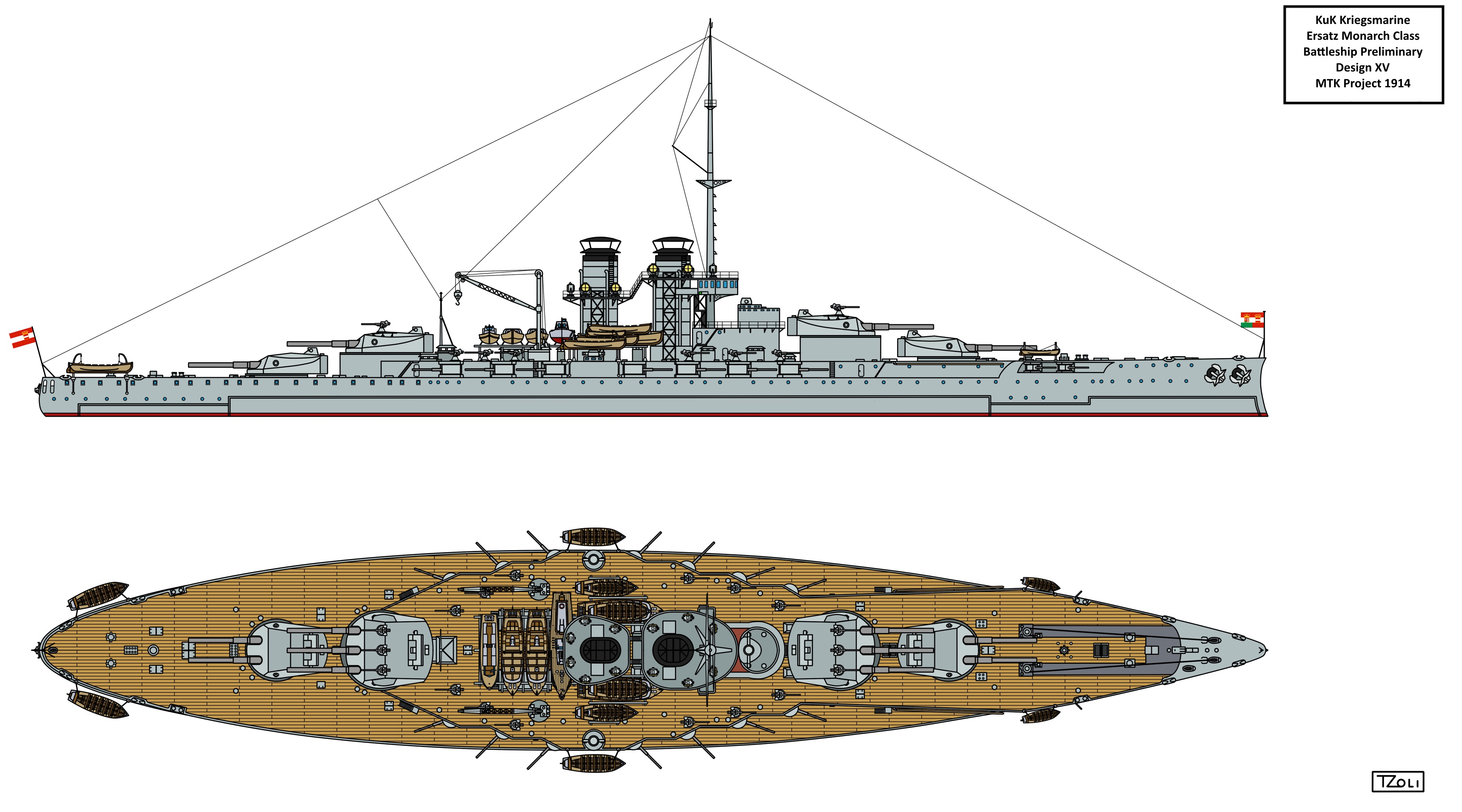
| |
Design XVI (July 1914) - Final Design
| Item | Description |
| Dimension: | 172 (wl), 173,2 (oa) x 28,5 x 8,4m |
| Displacement: | 24.560tons (standard) |
| Armour: | 310mm Belt 72mm Deck |
| Engines: | 31.000shp Steam Turbines, 4 shafts |
| Speed: | 39km/h (21knots) |
| Armament: | 2x3,2x2 35cm 14x1 15cm Casemated Guns 8x1 9cm Guns 12x1 9cm AA Guns 6x1 53cm Underwater Torpedo tubes |
